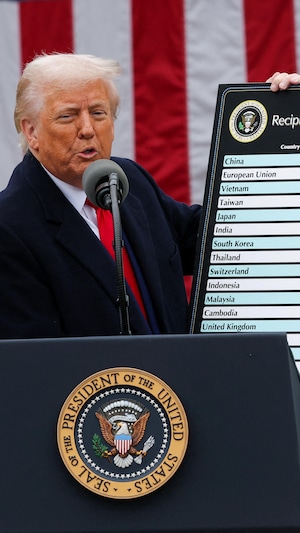
Tariff Diplomacy

The arrival of the Trump administration in power has brought with it a wave of uncertainty, particularly with regards to trade policy and tariffs. The methods employed, as well as Mr. Trump's arm-wrestling diplomatic approach, have already been the subject of several critics. In this article, we propose a theoretical analysis of current events, focusing on the underlying causes and on their impacts.
Understanding Tariffs
Tariffs are similar to a consumption tax imposed by the importing country, paid directly by the company importing the goods. The latter may raise its prices to preserve its margins, thus passing on the cost to the final consumer.
Indirectly, the exporting country also suffers the consequences and may therefore pay part of this form of tax: the tariff raises the price of the product on the importing market, which may reduce demand depending on the product's price elasticity. To compensate for this loss, the exporting company may then decide to lower its prices and, implicitly, its profit margins.
Although the exact impact of the tariffs is impossible to measure, the following effects can typically be expected:
- Tariffs reduce production efficiency on a global scale, with a stagflationary effect (fewer goods produced at higher costs, all due to a loss of global productivity). Overall, they are deflationary for the producer but inflationary for the importer imposng the tariffs.
- Tariffs protect local companies from foreign competition and reduce trade and financial imbalances, thus limiting dependence on foreign production and capital. This becomes an advantage in times of geopolitical tension, to ensure domestic production.
The objective of Tariffs
 First, it is important to note that the U.S. government debt has been increasing and that it is considered unsustaibable in the long term by the Congressional Budget Office (see figure 1). Since the 1970s, the U.S. has been running an annual trade deficit, a phenomenon that became more pronounced with the rapid industrialization of China in the early 2000s. This trade imbalance stems from the fact that the U.S. borrow to consume, while exporting countries like China - which lend to the U.S. - accumulate trade surpluses and depend on their exports to sustain their own economic growth.
First, it is important to note that the U.S. government debt has been increasing and that it is considered unsustaibable in the long term by the Congressional Budget Office (see figure 1). Since the 1970s, the U.S. has been running an annual trade deficit, a phenomenon that became more pronounced with the rapid industrialization of China in the early 2000s. This trade imbalance stems from the fact that the U.S. borrow to consume, while exporting countries like China - which lend to the U.S. - accumulate trade surpluses and depend on their exports to sustain their own economic growth.
Figure 1 : Federal Debt Held by the Public

Source : https://www.cbo.gov/publication/61172#_idTextAnchor038
This debt dynamic has been made possible by the U.S. dollar's status as the world's main reserve currency, enabling the U.S. to finance its deficits on advantageous terms. That said, it is important to note that the U.S., like many other developed countries, have benefited from globalization, which has enabled consumption at low cost, thanks to imports. However, in the context of increasing deglobalization and growing mistrust between major economic powers, this model based on persistent imbalances seems to become increasingly worrying.
The recent tariffs mark an important turning point. They call into question a global economic model that has persisted for many years, in which exporting countries like China produce at low cost, export massively - particularly to the United States - and accumulate large surpluses, while importing countries - particularly the United States - go into debt in order to consume.
The Trump administration's main objectives in imposing numerous tariffs seem to be threefold: to repatriate some manufacturing production in order to keep promises made to its electoral base, to secure supply chains in an increasingly uncertain geopolitical context, and to tackle the structural problem of American debt. It's a perilous goal, with several risks, and not without consequences.
Impact on Financial Markets so Far
 Since the beginning of the year, there has been a sharp decline in equity markets, as well as in U.S. bond markets and with the U.S. dollar relative to a basket of foreign currencies - two segments that typically serve as safe havens during times of market turmoil. Canadian and International stock markets have not been spared. In the current context, gold appears to be the only asset truly fulfiling its traditional role as a safe haven. This trend intensified particulary since April 2, dubbed "Liberation Day" when Mr. Trump unveiled a series of tariffs that the United States intend to impose on various countries, urging them to renegotiate trade terms deemed "more favorable." The situation worsened when China announced it would retaliate with its own countermeasures.
Since the beginning of the year, there has been a sharp decline in equity markets, as well as in U.S. bond markets and with the U.S. dollar relative to a basket of foreign currencies - two segments that typically serve as safe havens during times of market turmoil. Canadian and International stock markets have not been spared. In the current context, gold appears to be the only asset truly fulfiling its traditional role as a safe haven. This trend intensified particulary since April 2, dubbed "Liberation Day" when Mr. Trump unveiled a series of tariffs that the United States intend to impose on various countries, urging them to renegotiate trade terms deemed "more favorable." The situation worsened when China announced it would retaliate with its own countermeasures.
The table below shows the performance of selected stock market indices between the beginning of the year and April 10, 2025:
Market | Benchmark | Year to date 2025 | After April 2 |
| US Equities (USD) | S&P 500 | -10.1% | -7.1% |
| "Magnificent 7" (USD) | Roundhill Magnificent Seven ETF (MAGS) | -19.1% | -6.7% |
| Long-Term U.S. Treasury Bonds (USD) | iShares 20+ Year U.S. Treasury Bond ETF (TLT) | -1.0% | -5.5% |
| International Equities (Local currencies) | MSCI EAFE | -4.3% | -7.4% |
| Canadian Equities (CAD) | S&P/TSX | -6.2% | -9.0% |
| U.S. Dollar vs Basket of Foreign Currencies | DXY (ICE U.S. Dollar Index) | -7.0% | -2.8% |
| Gold (USD) | GC (CME Group - Gold Futures) | +18.3% | +0.5% |
To conclude, it should be noted that China exports around $550 billion worth of goods to the U.S. (average 2020 to 2023), while the U.S. exports around $150 billion to China (average 2020 to 2023). These figures underline the importance of their bilateral trade relations. Although this confrontation resembles a tug-of-war between these two superpowers, it is difficult to predict the outcome, which contributes to heightened market volatility. In a highly uncertain environment, the importance of diversification and risk management is clear, and it's vital to stay focused on the long term, since volatility is likely to remain high in the short term.





